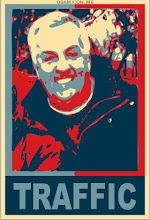By AMY RINARD, Milwaukee Jounral Sentinel, 07/13/08

Drivers can expect more roundabouts
Wisconsin motorists will be driving in circles more often over the next 10 years as there is likely to be six times the number of traffic roundabouts on state highways.
And that’s not counting the growing number of the circular intersections being built on local roads. “They’re going to be like dandelions; they’re going to be everywhere,” said state Department of Transportation spokesman Dennis Shook.
But even as DOT officials increasingly promote roundabouts as a safer, time-saving and more fuel-efficient alternative to traditional four-cornered intersections, roundabouts continue to be controversial in almost every community where they are proposed.
In Oconomowoc, where a roundabout on state Highway 16 downtown is under construction and set to open later this year, residents continue to debate its merits. Ald. David Nold, who was not on the Common Council when the plan was approved, said he hasn’t heard one person who wasn’t associated with the project say it was a good idea. He questions the roundabout’s price tag, including the city’s cost to buy and remove several downtown buildings to make way for it, and said DOT officials leaned on the city to approve the roundabout. “All over the place they’re putting in these roundabouts, somebody has this idea that it’s a good thing and they’re pushing it,” Nold said.
In 2004, the DOT implemented a policy requiring roundabouts to be considered for construction every time a four-way stop or a major improvement in an intersection on a state highway was planned. “A roundabout has equal weight to a traffic signal and the safety benefits are substantial,” said Patrick Fleming, a DOT standards development engineer who specializes in roundabouts. “You can’t go through a roundabout at high speed and your T-bone crashes are virtually eliminated.”
In a modern traffic roundabout, motorists enter an intersection by yielding the right-of-way on their left to vehicles already moving around a central, often-grassy circle. Drivers continue around the circle until they reach their destination street then turn right to exit the roundabout. If they miss their turn, motorists simply go around the circle again. The speed limit in a roundabout is usually 20 mph or 25 mph and it’s deliberately designed to make it very difficult to go faster than that. “The chances of killing someone at 20 mph are substantially less than the chances of killing someone at 55 mph,” Fleming said.
Improved safety cited
National studies have shown roundabouts reduce fatal crashes by 90%, injury crashes by 76% and crashes involving pedestrians by 30% to 40%. In addition, DOT officials say roundabouts save time because traffic moves through them in a continuous flow and there is no more sitting at red lights when there’s no cross traffic. Roundabouts also are said to conserve gas because there’s no stopping and starting of vehicles as traffic lights change because there aren’t any traffic lights.
Currently, there are 30 roundabouts on state highways plus about another 27 on local roads in Wisconsin, Fleming said. But as many as another 150 roundabouts are in various stages of planning on state highways and an undetermined, but increasing, number on local roads, he said.
Plans for a large new interchange at I-94 and Sawyer Road at Pabst Farms in Oconomowoc, for example, includes four roundabouts. A new three-lane roundabout is planned at I-43 and Moorland Road in New Berlin. It will join a two-lane roundabout already at that intersection. A roundabout is in the works for Highways 18 and 83 in Wales in Waukesha County.
Fleming acknowledges the controversy about roundabouts and said many people are just unfamiliar with them. “There’s probably a low sense of comfort when you’re going through them, maybe you’re a bit nervous,” he said. “But that may be a good thing; now you’re going slow, you’re watching everything, you’re more aware of the cars around you.”



No comments:
Post a Comment